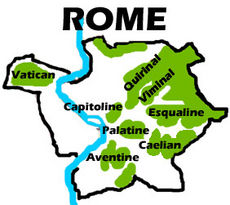Mystery Babylon
William Branham's teachings on Revelation 17 deserve some attention. Babylon: A city by another nameThe Book of Revelation is a book of symbols, and every word has a meaning. When Jesus preached on earth, he spoke in parables, and every object in these parables had a meaning. Although known for his compassion, Jesus spoke in parables so that other people would not understand what he meant (Matthew 13:13). The book of Revelation is the Revelation of Jesus Christ, and follows the pattern of parables and symbolism. Revelation 11:8 says, “the great city, which spiritually is called Sodom and Egypt, where also our Lord was crucified.” This scripture is speaking of Jerusalem physically, but revealing its underlying immorality. When the book of Revelation speaks of Babylon, it is identifying the spiritual failures of historical Babylon - confusion, anti-god, idol worship – but is speaking of another city: Rome. Rome: Sitting on Seven hills
The Seven Hills of Rome east of the Tiber form the heart of Ancient Rome. The original city was held to have been founded by Romulus on the Palatine Hill, and the other six hills are now called the Aventine, Capitoline, Quirinal, Viminal, Esquiline, and Caelian. The independent settlements on these hills began to unify into what is now known as Rome as the marshes between the hills were drained, and as inter-settlement religious games began to be held. The Identity of the Woman
William Branham stated that
But contrary to what William Branham stated, the Bible does not say refer to "the church setting on the seven hills". What it does say is that "the woman which thou sawest is that great city..." Jerusalem itself had been pictured as a harlot by both Isaiah[2] and Ezekiel[3]. Likewise Nahum describes Ninevah’s barbarities in terms of “the wanton lust of a harlot, alluring, the mistress of sorceries, who enslaved nations by her prostitution and peoples by her witchcraft”[4]. Similarly Isaiah’s litany over Tyre[5] calls for her to “take up a harp, walk through the city, you forgotten prostitute; play the harp well, sing many a song, so that you will be remembered.”[6] The typing of the city of Rome to a harlot is therefore imagery taken from the Old Testament, something that is common throughout the Book of Revelation. Another example of blasphemy is the hierarchy of Rome. The Bible instructs that Jesus Christ is the head of the church (Ephesians 5:23). By inserting a Pope and congregation of cardinals between the Churches and Jesus Christ (ie. between the body and the head), the Roman Catholic Church offers the spiritual equivalent of the guillotine to its followers.
Guilty of the Blood of the Martyrs
Rome persecuted the Christian church relentlessly once it turned on them. In fact, Nero ordered the death of believers in Rome using them as living torches for his infamous garden parties.[7]
Footnotes
|
